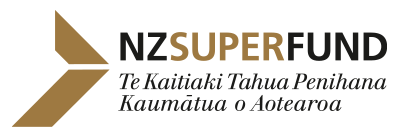Risk and volatility
For the Fund to meet a significant portion of the future cost of New Zealand Superannuation, the ability to take market risk to earn investment returns over long periods of time is crucial.
Market risk means the Fund will experience mark-to-market losses from time to time when financial markets fall in value.
In addition to taking market risk, the Fund’s endowments enable it to embrace active, contrarian investment strategies in order to further enhance returns.
Te mārō o te haere i ngā huringa o te wā
Staying the course through times of change
The Fund takes market risk to earn investment returns over the long-term
In keeping with the Fund’s long investment horizon, and in order to meet its mandate, we have deliberately weighted the Fund towards growth assets (80% equities, 20% fixed income). This is set by the Board in the Reference Portfolio, a simple passive low-cost portfolio of listed equities and bonds that serves as a benchmark for the Fund’s investing activities.
In the short-term, growth assets can be volatile, moving up and down in price. The Fund has the ability to ride out and potentially benefit from these short-term movements. In the long-term, the Fund’s exposure to market risk from growth assets such as shares is expected to pay off in the form of higher returns than the cost to the Government of contributing to the Fund.
In a market crisis, the Fund may suffer large financial losses
By taking on the market risk associated with growth assets, we accept the risk that markets may experience sharp drops in value, be they driven by financial or political shocks, large commodity price movements, natural disasters, or war. It is largely unavoidable that a growth-oriented portfolio such as the Fund will fall during these periods.
The Fund is well-placed to withstand such losses, as there is no immediate need to withdraw capital from it. Short-term, volatility in the Fund’s return is an expected outcome of the Board’s choice of the level of equities in the Reference Portfolio. These fluctuations can be treated as “paper losses” with little long-term ramifications for the Fund’s ability to fulfil its purpose.
Having made the choice to expose the Fund to short-term volatility in order to generate long-term returns, the key is to ensure we have the discipline and resources to hold the course when volatility happens. Critical in this is understanding what these times could look like before they happen.
For example, from peak to trough we estimate that the Fund would fall by 52.6% in a repeat of the Global Financial Crisis (GFC) of 2008 – 2011. The notional Reference Portfolio benchmark would fall by 44.7%.
The reason we estimate that the Fund would lose more money than the Reference Portfolio benchmark is largely because we expect our strategic tilting programme would buy more growth assets as they fall in value. This is because the times when the global economy and financial markets are in distress are those that present the best buying opportunities for long-term investors such as ourselves.
The Fund expects to recoup any investment losses over the recovery period
The GFC was characterised by both an unusually sharp drawdown and a rapid recovery in financial market values. This is a relatively rare occurrence; recoveries from significant market crises can often take longer than this. In general, however, we believe that equity markets eventually mean-revert to higher fair values following transitory periods of crisis. As a result, we expect the Fund would earn back losses suffered by our active investment strategies in subsequent years as markets recover. For example, in a repeat of the GFC the Fund would recover its initial value, and catch up lost ground, within 20 months.
Holding the course
The expected recovery in the Fund’s value is only feasible if we are able to “hold the course” with our investment strategies through a market cycle.
So, the major risk to the Fund is not that it will experience significant volatility in its returns – we know that will happen. The major risk to the Fund is that we lose our nerve, close down our investment positions and lock in the losses experienced in a crisis. This would significantly impair the ability of the Fund to fulfil its long-term purpose.
The years ahead
As the Fund becomes bigger in dollar terms, and grows as a share of the New Zealand economy, its gains and losses from short-term market volatility will also increase in size. We encourage stakeholders to understand that the main challenge in persisting as a long-horizon investor is in looking through short-term shifts in value and focusing instead on more appropriate and long-term metrics of success.
Even considering the risk of market crises, our view is that the Fund’s market risk and active investment strategies are appropriate and compensated risk exposures for a long-term investor.
